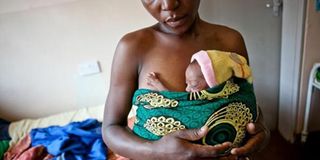The best care for premature babies

It is important to keep a premature baby warm. Mothers are taught kangaroo care so as to keep their babies warm.
Four-day-old Dennise looks frail as she lies with half-closed eyes in the incubator. She is heavily covered with blankets and baby sheets and has tubes in her tiny nose to aid her breathing.
The only visible thing is her tiny head, big as a fist of an adult; her fingers hidden beneath the covers move with little energy.
She was born barely seven months old weighing 800 grams and she is fighting for its dear life. Denise is in a room with three other babies; one set of twins each weighing 900 grams and another baby now knocking one kilogramme.
Dennise’s mother Prossy Nakayima says the birth came as a surprise as she did not have any problem during her pregnancy.
Nakayima is one of the women who give birth to about 20 premature babies every month at Jinja Regional Referral Hospital. The hospital’s neonatal unit, which now offers special care for premature babies, teaches mothers to care for their babies even out of the hospital.
The unit was set up under the Makerere University Centre of Excellence for Maternal and Newborn Health Research at the School of Public Health during the maternal-newborn scale up (Manescale) project.
According to Sister Anguparu Maburuka, the in-charge of the neonatal unit at the hospital, premature and sick babies now have a chance of survival at the hospital after nurses and midwives were given simple skills on how to care for them.
“Before, there were missed opportunities for survival for suchbabies but now, once they are brought to the hospital, their chance of survival is very high,” Sister Maburuka says.
But how does one save an 800 gramme baby? Sister Maburuka lists six steps:
Step 1
Warm the baby: once the baby is born, he or she needs warmth because they can easily develop hypothermia, a condition brough about by coldness in premature babies. To keep a baby warm, they should be covered and put in an incubator simultaneously.
Once warm, the kangaroo mother care is introduced, although it takes time for this to happen.
Dr Jude Mulowooza, head of Department of Obstetrics and Gynaecology at Iganga hospital says if the incubator is unavailable, there is no way of regulating temperature since those who need it are the unstable ones.
Step 2
Put the baby on oxygen. Once warm, the nurse should carry out a continuous positive airway pressure test to check for oxygen circulation. This is done using an electricity-enabled oxygen therapy concentrator.
Without one, there is likelihood that the baby’s life will be lost.
Step 3
Introduce glucose. When a baby has low glucose, they acquire neonatal hypoglycemia. The baby needs glucose for energy despite most of it being used by the brain.
Because they (babies) get glucose from the mother through the placenta in the womb, they are supposed to get it from breast milk after birth and produce it through the liver.
However, prematures are not introduced to breast milk immediately and the breasts may not be able to produce it, which calls for external aid.
Sister Maburuka says the baby is at this time administered with 10 per cent of glucose through the veins. She goes on to add that at this time, breast milk can be introduced although it depends on the weight of the baby.
“If the baby is below 1 kilogramme, glucose is administered for three days before breast milk is introduced but if above, then it can be introduced after a day or two,” she adds.
Step 4
Antibiotics. Once born, the baby’s immunity is low, which could easily result into infections. That is why ampicillin and gentamicin antibiotics are administered at this stage.
Step 5 and 6
Kangaroo mother care and educating the mother; during this time, the mother is told that the baby’s care is also dependent upon her. The kangaroo mother care is meant to help give the baby more warmth and also bond with the mother so as she or he might accept to be fed with breast milk.
Sister Maburuka says mothers are then sensitised on the use of kangaroo mother care, importance of hygiene and general care for the baby.
In an ideal situation, Dr Mulowooza says every eligible hospital or health centre to carry out child births should have an incubator, antibiotics, feeding tube and oxygen. However this is not the case, which calls for the strengthening of the referral system.
“There are indicators that a mother may give birth prematurely and hospitals should do everything possible to minimise what would go wrong. But if they lack certain equipment, then it calls for referral,” Dr Mulowooza adds.
Phillip Wanduru, the coordinator Manescale Project, says neonatal survival largely depends on how they are handled and after birth.
However, most nurses and midwives do not know how to manage them, especially pre-matures, which leads to a high mortality rate.
“Saving lives is dependent on simple interventions such as kangaroo mother care but mothers come late and even though you try to save them, it is late,” Mr Wanduru says.
For Denise, the battle still goes on until she is able to breathe, feed and have a normal body temperature. Unlike her, thousands have passed on due to lack of these simple saving tips.




